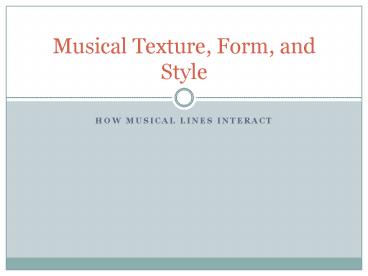How musical lines interact - PowerPoint PPT Presentation
1 / 12
Title:
How musical lines interact
Description:
Musical Texture refers to a number of different characteristics of music ... Example: Dance of the Reed Pipes from The Nutcracker Suite- By Peter Tchaikovsky ... – PowerPoint PPT presentation
Number of Views:98
Avg rating:3.0/5.0
Title: How musical lines interact
1
Musical Texture, Form, and Style
- How musical lines interact
2
What is Musical Texture?
- Musical Texture refers to a number of different
characteristics of music - Texture is the number of parts playing
- It refers to whether each line is a melody or
harmony part - Texture refers to how each part relates to each
other - Can be described as thick, thin, dense, heavy,
light - Variations in texture can create contrast and
drama - We will look at three basic textures
- Monophonic
- Polyphonic
- Homophonic
3
Monophonic Texture- One Sound
- Monophonic means that there is one melodic line
with no harmony or accompaniment - If multiple voices or instruments are playing in
unison, it is still Monophonic - Examples of monophonic music
- Singing solo a capella
- Gregorian chant
- Unaccompanied instrumental sonatas
4
Polyphonic Music- Many Sounds
- Polyphonic means that there are two or more
melodic lines of equal importance - Technique of writing several melodic lines that
interact is called counterpoint - Often uses imitation, which is when one voice or
instrument presents a melodic idea, then another
voice repeats it - Not always exact imitation
- Examples of polyphonic music
- Rounds, fugues, and canons
- Partner songs
5
Homophonic Music- Same Sounds
- Homophonic means there is one main melody with a
less important accompaniment - Accompaniment could be as simple as chords, or it
could be more complex - If a line in the accompaniment starts to stand
out and become more important, then the texture
changes to polyphonic - Examples of homophonic music
- Melody and accompaniment
- Traditional hymn arrangments
6
Farandole by Georges Bizet
- Has two themes a march theme and a dance theme
- Starts with the march theme in a homophonic
texture, then then violins and violas play a
polyphonic section - The high woodwinds then play the dance theme in a
homophonic texture - After the full orchestra plays the dance theme,
the strings play a monophonic version of the
march theme - Listen for other changes in texture
7
Hallelujah by Georg Frideric Handel
- Switches rapidly between all three textures
- Word Hallelujah is usually homophonic, with
some imitative polyphony - For the Lord God omnipotent reigneth is usually
monophonic - And he shall reign is always polyphonic
- Changes in texture create contrast for each
section of the piece
8
MUSICAL FORM
- Three techniques that create Form
- Repetition
- Allows the listener to become familiar with a
theme or melody - Often used with another technique
- Contrast
- Can be a change of mood, dynamics, tempo, timbre
- Variation
- Alteration of a musical idea so its different
but still recognizable - Entire pieces can be composed using this technique
9
Two Major types of Form
- Ternary Form
- Three sections A B A
- Can be looked at as a statement of a theme, a
contrasting section, and a return to the original - Each section can also be subdivided, as well
- Example Dance of the Reed Pipes from The
Nutcracker Suite- By Peter Tchaikovsky - A section introduces the melody
- B section uses the trumpets and strings to vary
the melody - Return to the A section with the flutes
10
Two Major types of Form
- Binary Form
- Two sections A B
- Can be looked at as a statement of a theme and
then a counterstatement with a different theme. - Any section can be repeated
- Example Contradance No. 7 in E-Flat Major By
Ludwig Von Beethoven - A section uses the 1st violins to introduce the
melody, then it is repeated - B section uses a rapid ascending scale, and gives
a sense of finality to the piece
11
Musical Style
- Style- a characteristic way of using melody,
rhythm, harmony, dynamics, timbre, texture, and
form. - Particular combinations create a distinctive
sound - Composers from the same area, time, or country
often use similar styles - Musical styles change over time, but it is often
gradual
12
Eras of Western Art Music
- Middle Ages (450-1450)
- Renaissance (1450-1600)
- Baroque (1600-1750)
- Classical (1750-1820)
- Romantic (1820-1900)
- Twentieth Century to 1945
- 1945 to the Present































